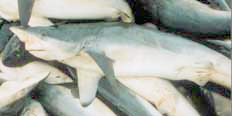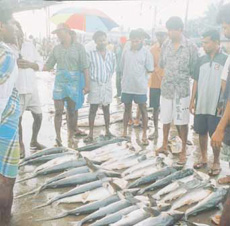
31st October 1999
Front Page|
News/Comment|
Editorial/Opinion| Business|
Sports|
Sports Plus| Mirror Magazine

![]()

- In the soup
- A lion comes to life again
- It was an evening of sheer delight
- Witty, illuminating and full of colour
- Giving life to a forgotten milieu
- The funny game called test cricket
- Now, beach dumps
- My adventures in Bangkok
- In aid of AIDS
- Ants in the garland
- What he taught us
- Medical Measures
- An artist of the paper world
- In constant transition
- Dangerous situation confronting journalists
- Dayamina: Happy tenth anniversary
- In the silence of the night…
- Letters to the editor








In the soup
The demand for shark fin soup has put this fierce predator into troubled waters. Udena R. Attygalle reports
The product of thousands of years of evolution, the shark is a fearsome predator. Yet in the hands of man and his ingenious fishing methods even the mighty shark is humbled. The great demand for shark fins is causing shark populations the world over to dwindle alarmingly.
Research Officer Devapriya Amerasuriya at the National Aquatic Resources,
Research and Development Agency (NARA) says that 1,14,545 metric tons of
marine fish were brought ashore last year. Of this 25,004 metric tons were
shark, mainly the variety known as silky shark. Most of the catch is from
offshore fishing while a small percentage is from coastal fishing. The
peak season for  shark
fishing is from January to April.
shark
fishing is from January to April.
When The Sunday Times visited the fish auction in Negombo early last week, the section where shark fish was being sold was a hive of activity. The smell of ammonia was very strong. Almost every part of the shark was being chopped off and auctioned. In addition to the flesh of the fish, the fins, and even the intestines (used as bait for crabs ) were sold. But it was alarming to see a large number of juvenile sharks, even foetuses and eggs strewn around.
These days a kilo of shark is sold for around Rs 40-60. But the fish is not where the market is. Shark fins are in high demand and fetch a good price. A kilo of wet fins can usually be sold for about Rs 2000. Most of the shark fish and even some of the intestines are usually used in the production of dried fish as the fish is already not suitable for human consumption.
When the consignment arrives at Colombo's St John's market, the sharks are already finned and cut except for the smallest sharks.
There are some varieties like the whale shark (the biggest fish in the world ) that is never eaten.
Lalith Ameralal, a research officer at NARA's social economy division
says that shark fins are usually dried and then exported mainly to Singapore,
Malaysia and Hong Kong. In this dry stage a kilo of  fins
would cost around Rs 3500. These fins when processed form the major ingredient
of shark fin soup, a delicacy in East-Asian countries.
fins
would cost around Rs 3500. These fins when processed form the major ingredient
of shark fin soup, a delicacy in East-Asian countries.
Chamila Jayasinghe, researcher at the Institute of Post-Harvest Technology says these fins are nearly 92 percent protein and hence very nutritious.
Most of the fins are that of the Hammerhead shark. The fins are sold in sets.( i.e the two pectoral fins, the lower lobe of the tail fin and the first dorsal fin form a set). The tail fin is the most sought after. According to Mr. Ameralal, 76, 496 kg of shark fin had been exported in 1998.
Shark fin soup is available at certain Chinese restaurants in Colombo. At the Flower Drum restaurant in Colombo 7, a bowl for one is priced at Rs 300. "Many foreigners and even locals have acquired a taste for this dish," the manager said. Yet this nutritious dish remains largely unknown in the country. The manager added that the restaurant buys a kilo of processed shark fin for Rs 2100.
Regular fishing has depleted the shark base in Sri Lanka so much that local fishermen are forced to fish in international and even foreign waters. Fishermen sail as far as the Seychelles islands to the west, the Andaman islands to the east and the Lakdive islands in the Arabian Sea. These excursions usually take around 30 days. One fisherman told The Sunday Times that his boat had gone as far as Somalia in Africa.
Meanwhile Dr Hiran Jayawardena of the Indian Ocean Marine Affairs Co-operation Secretariat (IOMAC )says, "IOMAC will be pressing for the regulation of shark fishing in Sri Lanka." Recent studies have revealed that wherever there has been a targeted fishery of a particular species of shark, the catch rate will peak within a few decades and be followed immediately by a drastic decline.
Dr Jayawardena continued, "Sri Lanka may be in the forefront of shark fishing in the Indian ocean."
Sri Lanka's overfishing of this top level predator may in the end have a drastic effect on the marine diversity of our water.
Rare sightings
Rex De Silva in the Sesquicentennial Commemorative Volume of the Royal Asiatic Society of Sri Lanka records a sighting of the legendary Great White Shark, the most feared of the man-eating sharks, in Sri Lankan waters. The record states, "It is a temperate zone species which rarely enters tropical waters: however, in April 1965, the writer examined a dead specimen at Galle." Anecdotal evidence indicates that on rare occasions the species is caught in Sri Lankan coastal waters.
Diver Prassana Weerakkody says, "Great Basses in the Yala coast and the Kalpitiya bar reef are among the last coastal places that have a sizable shark population." The offshore reef in Hikkaduwa too has been a good "shark spot".
The number of shark species recorded in Sri Lankan waters in 1995 was 51.
Shark cures
The fact that sharks have never been recorded to have been inflicted with cancer has whetted the interest of researchers. Today shark cartilage is being used in many countries as treatment against the dreaded disease. Shark cartilage is also used for treatment of arthritis.
Shark liver oil has been used for centuries as a salve or taken orally. Now modern science is proving the wisdom of this time - honoured practice. This liver oil contains a high concentration of G-E lipids; known to promote good health. High concentrations of this lipid in organs with important immune functions such as lymph nodes, liver, spleen and bone marrow may be an indication of its importance. Shark skin too may be used to make leather.
In the United States shark corneas have been successfully transplanted to humans.
Unfortunately most of the shark liver oil and almost all of the cartilage and skin go to waste in the Sri Lankan fishing industry.
![]()
Front Page| News/Comment| Editorial/Opinion| Plus| Business| Sports| Sports Plus| Mirror Magazine
Please send your comments and suggestions on this web site to

